Xin Ju
Dual-Functional MIMO Beamforming Optimization for RIS-Aided Integrated Sensing and Communication
Jul 17, 2023
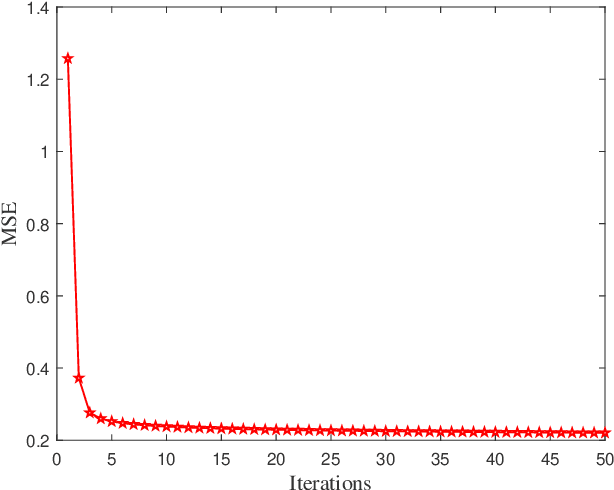
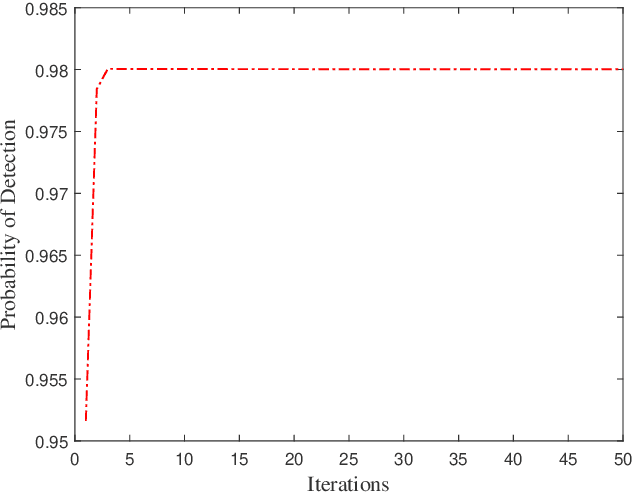
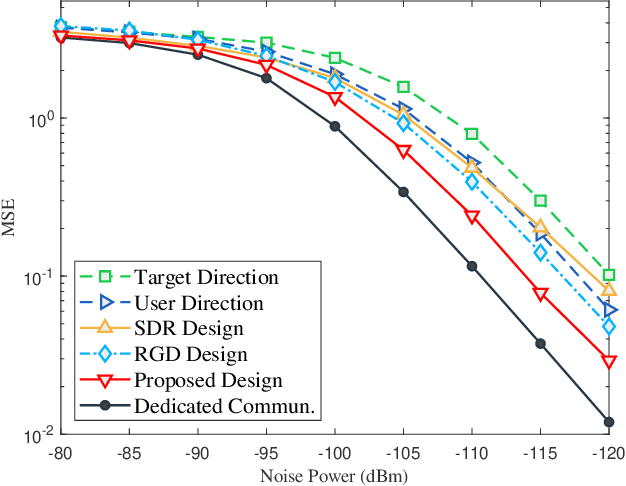
Abstract:Aiming at providing wireless communication systems with environment-perceptive capacity, emerging integrated sensing and communication (ISAC) technologies face multiple difficulties, especially in balancing the performance trade-off between the communication and radar functions. In this paper, we introduce a reconfigurable intelligent surface (RIS) to assist both data transmission and target detection in a dual-functional ISAC system. To formulate a general optimization framework, diverse communication performance metrics have been taken into account including famous capacity maximization and mean-squared error (MSE) minimization. Whereas the target detection process is modeled as a general likelihood ratio test (GLRT) due to the practical limitations, and the monotonicity of the corresponding detection probability is proved. For the single-user and single-target (SUST) scenario, the minimum transmit power of the ISAC transceiver has been revealed. By exploiting the optimal conditions of the BS design, we validate that the BS is able to realize the maximum power allocation scheme and derive the optimal BS precoder in a semi-closed form. Moreover, an alternating direction method of multipliers (ADMM) based RIS design is proposed to address the optimization of unit-modulus RIS phase shifts. For the sake of further enhancing computational efficiency, we also develop a low-complexity RIS design based on Riemannian gradient descent. Furthermore, the ISAC transceiver design for the multiple-users and multiple-targets (MUMT) scenario is also investigated, where a zero-forcing (ZF) radar receiver is adopted to cancel the interferences. Then optimal BS precoder is derived under the maximum power allocation scheme, and the RIS phase shifts can be optimized by extending the proposed ADMM-based RIS design. Numerical simulation results verify the performance of our proposed transceiver designs.
Learning CO$_2$ plume migration in faulted reservoirs with Graph Neural Networks
Jun 16, 2023



Abstract:Deep-learning-based surrogate models provide an efficient complement to numerical simulations for subsurface flow problems such as CO$_2$ geological storage. Accurately capturing the impact of faults on CO$_2$ plume migration remains a challenge for many existing deep learning surrogate models based on Convolutional Neural Networks (CNNs) or Neural Operators. We address this challenge with a graph-based neural model leveraging recent developments in the field of Graph Neural Networks (GNNs). Our model combines graph-based convolution Long-Short-Term-Memory (GConvLSTM) with a one-step GNN model, MeshGraphNet (MGN), to operate on complex unstructured meshes and limit temporal error accumulation. We demonstrate that our approach can accurately predict the temporal evolution of gas saturation and pore pressure in a synthetic reservoir with impermeable faults. Our results exhibit a better accuracy and a reduced temporal error accumulation compared to the standard MGN model. We also show the excellent generalizability of our algorithm to mesh configurations, boundary conditions, and heterogeneous permeability fields not included in the training set. This work highlights the potential of GNN-based methods to accurately and rapidly model subsurface flow with complex faults and fractures.
A Deep Learning-Accelerated Data Assimilation and Forecasting Workflow for Commercial-Scale Geologic Carbon Storage
May 09, 2021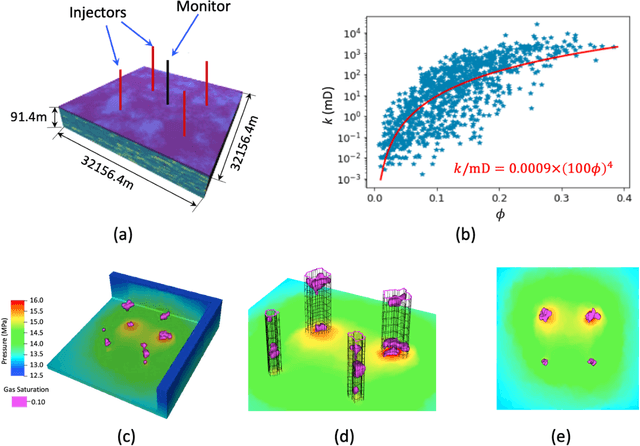



Abstract:Fast assimilation of monitoring data to update forecasts of pressure buildup and carbon dioxide (CO2) plume migration under geologic uncertainties is a challenging problem in geologic carbon storage. The high computational cost of data assimilation with a high-dimensional parameter space impedes fast decision-making for commercial-scale reservoir management. We propose to leverage physical understandings of porous medium flow behavior with deep learning techniques to develop a fast history matching-reservoir response forecasting workflow. Applying an Ensemble Smoother Multiple Data Assimilation framework, the workflow updates geologic properties and predicts reservoir performance with quantified uncertainty from pressure history and CO2 plumes interpreted through seismic inversion. As the most computationally expensive component in such a workflow is reservoir simulation, we developed surrogate models to predict dynamic pressure and CO2 plume extents under multi-well injection. The surrogate models employ deep convolutional neural networks, specifically, a wide residual network and a residual U-Net. The workflow is validated against a flat three-dimensional reservoir model representative of a clastic shelf depositional environment. Intelligent treatments are applied to bridge between quantities in a true-3D reservoir model and those in a single-layer reservoir model. The workflow can complete history matching and reservoir forecasting with uncertainty quantification in less than one hour on a mainstream personal workstation.
Deep-learning-based coupled flow-geomechanics surrogate model for CO$_2$ sequestration
May 04, 2021
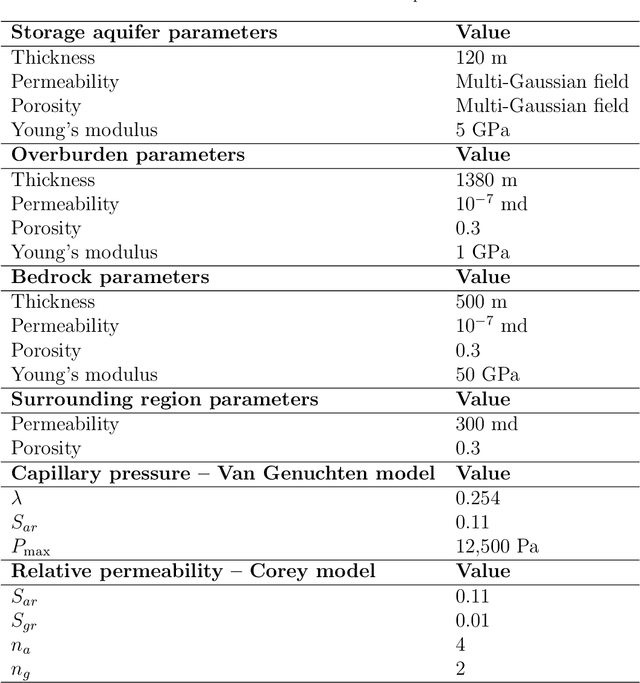
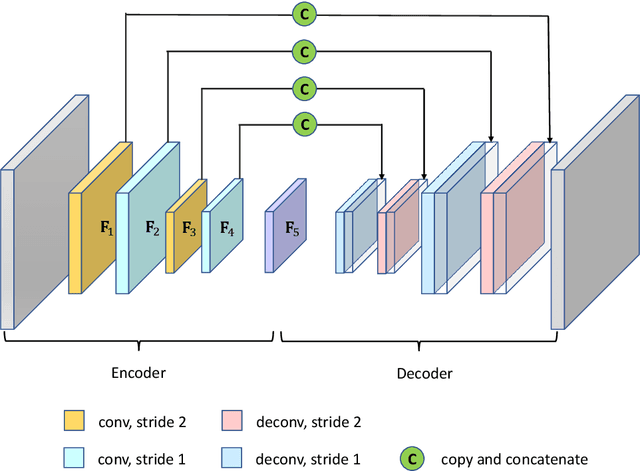
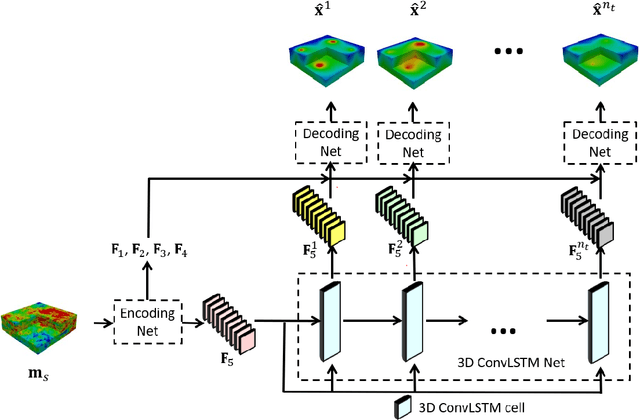
Abstract:A deep-learning-based surrogate model capable of predicting flow and geomechanical responses in CO2 storage operations is presented and applied. The 3D recurrent R-U-Net model combines deep convolutional and recurrent neural networks to capture the spatial distribution and temporal evolution of saturation, pressure and surface displacement fields. The method is trained using high-fidelity simulation results for 2000 storage-aquifer realizations characterized by multi-Gaussian porosity and log-permeability fields. These numerical solutions are expensive because the domain that must be considered for the coupled problem includes not only the storage aquifer but also a surrounding region, overburden and bedrock. The surrogate model is trained to predict the 3D CO2 saturation and pressure fields in the storage aquifer, and 2D displacement maps at the Earth's surface. Detailed comparisons between surrogate model and full-order simulation results for new (test-case) storage-aquifer realizations are presented. The saturation, pressure and surface displacement fields provided by the surrogate model display a high degree of accuracy, both for individual test-case realizations and for ensemble statistics. Finally, the the recurrent R-U-Net surrogate model is applied with a rejection sampling procedure for data assimilation. Although the observations consist of only a small number of surface displacement measurements, significant uncertainty reduction in pressure buildup at the top of the storage aquifer (caprock) is achieved.
 Add to Chrome
Add to Chrome Add to Firefox
Add to Firefox Add to Edge
Add to Edge